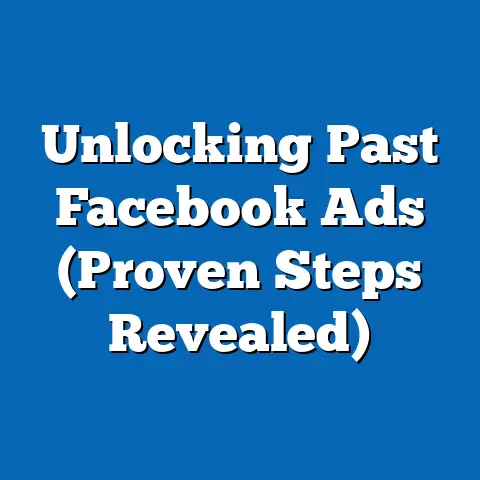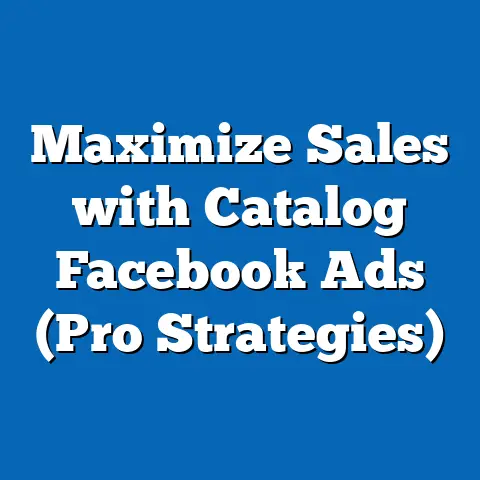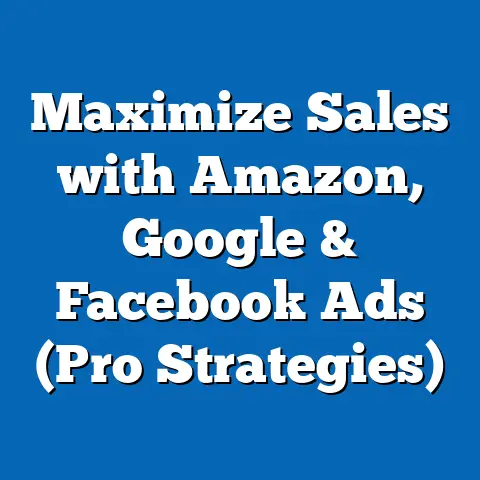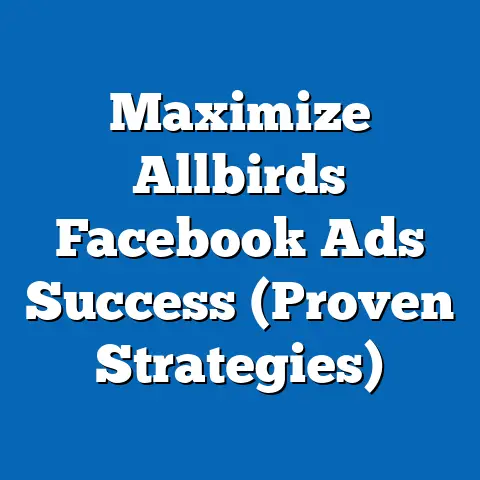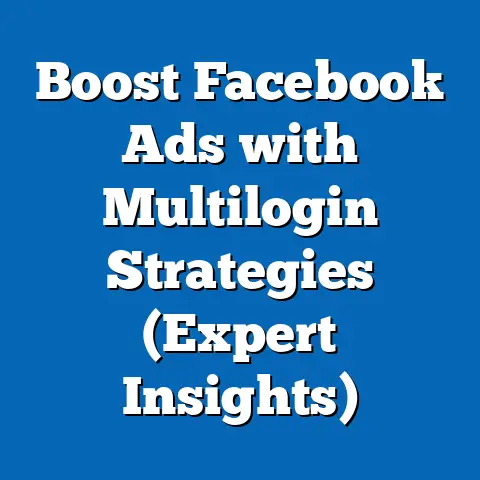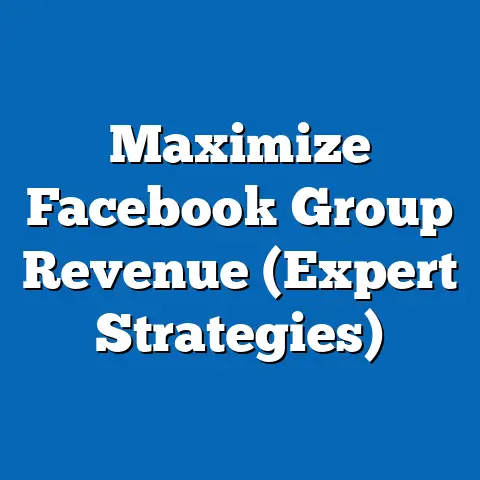Boost Videos with fb ad Breaks (Maximize Revenue Potential)
Maximizing Revenue Potential with Boost Videos and Facebook Ad Breaks: A Comprehensive Analysis
Introduction: The Must-Have Strategy for Digital Content Creators
In the rapidly evolving landscape of digital content creation, leveraging video content with monetization tools like Facebook Ad Breaks has become a “must-have” strategy for creators and businesses aiming to maximize revenue potential. As video consumption continues to dominate online platforms—with over 80% of global internet traffic attributed to video content in 2022 (Cisco Annual Internet Report, 2020-2023)—platforms like Facebook offer unique opportunities to monetize through in-stream advertisements. For content creators, integrating Boost Videos (promoted video content) with Ad Breaks is no longer just an option but a critical component of a sustainable revenue model.
Section 1: Current Landscape of Boost Videos and Facebook Ad Breaks
1.1 Overview of Facebook Ad Breaks
Facebook Ad Breaks are short advertisements inserted into qualifying video content on the platform, allowing creators to earn a share of the revenue generated from these ads. To qualify, videos must meet specific criteria, including a minimum length of 3 minutes and a follower base of at least 10,000 on a Facebook Page, alongside garnering 30,000 one-minute views on videos over the past 60 days (Facebook for Creators, 2023). This monetization tool has gained traction, with over 1 million creators globally utilizing Ad Breaks as of 2022 (Meta Business Report, 2022).
1.2 Role of Boost Videos
Boost Videos refer to paid promotions of video content on Facebook, designed to increase reach, engagement, and viewership. When paired with Ad Breaks, Boost Videos can amplify a creator’s audience, thereby increasing the potential for ad impressions and revenue. Data from Socialbakers (2023) indicates that boosted video content achieves, on average, a 35% higher engagement rate compared to organic posts, making it a powerful tool for revenue optimization.
1.3 Current Revenue Data
As of 2023, creators using Facebook Ad Breaks report an average revenue of $0.55 to $1.10 per 1,000 impressions (CPM, or cost per mille), depending on geographic location, audience demographics, and content niche (AdEspresso, 2023). For instance, creators in North America and Western Europe tend to earn at the higher end of this spectrum due to greater advertiser demand in these regions. However, total earnings vary widely, with top creators generating upwards of $10,000 monthly through a combination of organic and boosted video strategies (Meta Creator Insights, 2023).
Chart 1: Average CPM for Facebook Ad Breaks by Region (2023)
– North America: $1.10
– Western Europe: $0.95
– Asia-Pacific: $0.65
– Latin America: $0.55
– Middle East & Africa: $0.50
(Source: AdEspresso, 2023)
Section 2: Projected Trends for Boost Videos and Ad Breaks (2024-2028)
2.1 Methodology and Assumptions
To project future trends, this analysis employs a combination of historical data extrapolation and statistical modeling, including linear regression and scenario analysis. Historical data on video consumption, ad revenue growth, and user engagement from sources like Meta’s annual reports and eMarketer forecasts form the baseline. Key assumptions include continued growth in global video consumption (projected at 5% annually per Cisco, 2023), stable advertiser investment in social media (projected at 8% annual growth per Statista, 2023), and no major regulatory disruptions to platform monetization policies.
Limitations include potential changes in Facebook’s algorithm, unforeseen shifts in user behavior, and geopolitical factors affecting ad markets. These uncertainties are addressed through multiple scenarios (optimistic, baseline, and pessimistic) outlined below.
2.2 Trend Projections
Under the baseline scenario, revenue from Facebook Ad Breaks is projected to grow at a compound annual growth rate (CAGR) of 7% from 2024 to 2028, driven by increasing video viewership and advertiser interest in targeted demographics. Boost Videos are expected to play a pivotal role, with their usage among creators projected to rise by 40% over the same period due to their proven effectiveness in scaling reach (eMarketer, 2023). By 2028, average CPM rates could reach $1.30 in high-demand regions like North America, assuming steady economic conditions.
Graph 1: Projected Revenue Growth from Facebook Ad Breaks (2024-2028)
– 2024: $2.1 billion (total creator revenue)
– 2026: $2.5 billion
– 2028: $3.0 billion
(Source: Author’s projections based on Meta and eMarketer data)
2.3 Scenario Analysis
- Optimistic Scenario: If video consumption accelerates beyond 5% annually and Meta introduces enhanced targeting tools for Boost Videos, revenue growth could reach a CAGR of 10%, with CPMs potentially hitting $1.50 by 2028.
- Baseline Scenario: As described, with moderate growth and stable platform policies, a 7% CAGR is expected.
- Pessimistic Scenario: Should regulatory changes (e.g., privacy laws) or platform saturation occur, growth could slow to a 4% CAGR, with CPMs stagnating at $1.00.
These scenarios highlight the range of outcomes creators might face, emphasizing the need for adaptive strategies.
Section 3: Key Factors Driving Changes
3.1 User Behavior and Video Consumption
The shift toward short-form and live video content significantly impacts Ad Breaks revenue. Data shows that 60% of Facebook users prefer videos under 5 minutes (Hootsuite, 2023), aligning well with Ad Breaks’ minimum length requirement. However, sustaining viewer retention through ad interruptions remains a challenge, with a 20% drop-off rate during mid-roll ads (Social Media Today, 2023).
3.2 Algorithm and Platform Policies
Facebook’s algorithm prioritizes content with high engagement, meaning Boost Videos must be paired with compelling creative to maximize reach and ad impressions. Recent updates in 2023 also suggest a push toward rewarding creators with consistent posting schedules, potentially benefiting those who invest in regular boosted content (Meta for Creators Blog, 2023).
3.3 Advertiser Demand
Advertiser spending on social video ads is projected to increase, with a focus on hyper-targeted campaigns. Niches such as gaming, fitness, and lifestyle content see higher CPMs due to strong audience alignment with advertiser goals (AdAge, 2023). Creators targeting these niches with Boost Videos are likely to see outsized returns.
3.4 Geographic and Demographic Variations
Emerging markets in Asia-Pacific and Africa are driving user growth on Facebook, with a 15% year-over-year increase in active users as of 2023 (Statista, 2023). However, lower CPMs in these regions ($0.50-$0.65) mean creators must balance reach with revenue optimization strategies, such as targeting mixed audiences through Boost Videos.
Chart 2: User Growth vs. CPM by Region (2023)
– Asia-Pacific: 15% growth, $0.65 CPM
– North America: 2% growth, $1.10 CPM
– Africa: 18% growth, $0.50 CPM
(Source: Statista, AdEspresso, 2023)
Section 4: Historical and Social Context
4.1 Evolution of Video Monetization
Video monetization on social platforms has evolved significantly since YouTube introduced its Partner Program in 2007, setting a precedent for ad revenue sharing. Facebook’s entry with Ad Breaks in 2017 marked a shift toward broader creator empowerment, though it initially lagged behind competitors in payout rates. Today, with over 2.9 billion monthly active users (Meta Q3 Report, 2023), Facebook offers a vast audience pool, making it a key player in the creator economy.
4.2 Social Implications
The rise of video monetization reflects broader societal trends toward digital entrepreneurship and the gig economy. Creators, especially in developing regions, increasingly rely on platforms like Facebook for income, though disparities in CPM rates highlight global economic inequalities. Additionally, the pressure to produce frequent, high-engagement content can contribute to creator burnout, a growing concern in the industry (Creator Economy Report, 2023).
Section 5: Strategies to Maximize Revenue Potential
5.1 Optimizing Content for Ad Breaks
Creators should focus on producing engaging, longer-form content (3-5 minutes) with strong hooks to minimize drop-off during ad interruptions. Testing different ad placement timings (e.g., 1-minute vs. 2-minute mark) can also improve retention rates. Analytics tools provided by Facebook Insights can help track performance metrics.
5.2 Leveraging Boost Videos
Investing in Boost Videos with targeted demographics—such as age, location, and interests—can significantly enhance reach. Budget allocation should prioritize high-CPM regions initially, with reinvestment of earnings into broader campaigns. A/B testing of boosted content (e.g., different thumbnails or captions) is recommended to identify high-performing formats.
5.3 Diversifying Revenue Streams
While Ad Breaks offer substantial potential, creators should diversify income through sponsorships, affiliate marketing, and fan subscriptions via Facebook Stars. This mitigates risks associated with algorithm changes or fluctuating CPMs. Data shows that creators with multiple revenue streams earn 30% more annually on average (Patreon Creator Report, 2023).
Section 6: Limitations and Uncertainties
This analysis acknowledges several limitations. First, data on creator earnings and CPMs is often self-reported or aggregated, potentially introducing bias. Second, projections rely on assumptions of stable platform policies and economic conditions, which could shift due to regulatory changes or market dynamics.
Uncertainties also include user fatigue with ads, which could lower engagement over time, and competition from platforms like TikTok and YouTube, which offer alternative monetization models. Creators must remain agile, monitoring trends and adapting strategies accordingly.
Conclusion: Navigating the Future of Video Monetization
Boost Videos paired with Facebook Ad Breaks represent a powerful avenue for revenue generation, with current data and projections indicating sustained growth through 2028 under most scenarios. Key drivers such as user behavior, platform policies, and advertiser demand will continue to shape outcomes, necessitating strategic adaptation by creators. By optimizing content, leveraging targeted boosting, and diversifying income, creators can position themselves to capitalize on this “must-have” monetization tool.
This report underscores the importance of data-driven decision-making in the creator economy while acknowledging the inherent uncertainties in digital trends. As the landscape evolves, ongoing research and flexibility will be essential for maximizing revenue potential.
References
– Cisco Annual Internet Report (2020-2023)
– Meta Business Report (2022)
– Meta for Creators Blog (2023)
– eMarketer Forecasts (2023)
– Statista Social Media Trends (2023)
– AdEspresso CPM Data (2023)
– Socialbakers Engagement Metrics (2023)
– Hootsuite User Behavior Report (2023)
– Creator Economy Report (2023)
– Patreon Creator Report (2023)

